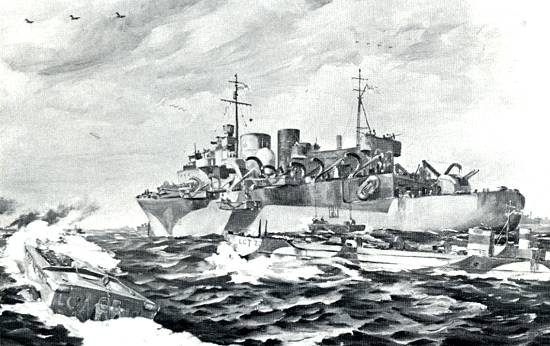THE RCN ON D-DAY
Page 6: Protecting the Beachhead
Originally
published in the "Crowsnest Magazine" Vol. 16 No. 5 May
1964
By Lt. Peter Ward, RCNR
|
|
|
|
|
The
stream of men and supplies moved endlessly across the channel and
into the beach at Normandy. By June 11, 357,000 troops had been
landed with 50,228 vehicles and 59,961 tons of supplies. In a month
the total reached the staggering figure of a million men landed,
plus 200,000 vehicles and 650,000 tons of supplies. About half were
American men, supplies and machines. The rest were British, Canadian
and free European forces.
The story of how those ships were protected for that long first month is another part of the contribution ships and men of the RCN made in the beginning of the end for Hitler’s Germany.
Destroyers, frigates, corvettes and MTBs all shared the Important job of providing the screen for the endless stream of ships that turned the Channel into an allied rush-hour highway. Enemy E and R-boats made several attempts to break through and attack but each time they were turned aside.
On June 9 Tribals of the 10th Flotilla engaged a force of two German Narvik class destroyers, one former Dutch destroyer, and one Elbing. They sank one Narvik and damaged the other. They sank the Tjerk Hiddes and badly damaged the Elbing. HMC Ships HaWa and Huron dogged one Narvik for hours, playing hide and seek through mine fields, then finally pumped salvo after salvo into her, drove her ashore near lie de Bas, and left her a flaming hulk. This was the only German attempt at a breakthrough in force. The action broke the back of German attempts to attack ships which supplied the invading forces.
On
June 7 HMC Ships Qu’Appelle, Saskatchewan, Skeeno. and Restigouche,
part of the force assigned to keep Uboats out of the Channel, made
a good submarine contact about 45 miles northwest of Ushant. The
submarine fired acoustic torpedoes at the destroyers, played hide
and seek through shoals of fish, twisted through tidal currents
and finally escaped by running submerged into the areas where the
Haida and Huron were operating. The Tribals were after bigger surface
game and the subchasing destroyers were ordered to keep clear of
the area lest they get shot up by accident.
The 24-hour chase saw the submarine fire eight acoustic torpedoes at the attacking Canadian destroyers, not one of which damaged them, thanks to CAT gear trailed astern.C
* The
CAT gear (Canadian Anti-Acoustic Torpedo gear) was a noise-making
device towed astern to deflect the sound-guided torpedoes away from
the ship’s propeller.
A week
later the four sub-hunting partners again ran afoul of the Haida
and Huron. They were illuminated by the Tribals’ star shells
in the dead of night. There was more than one sigh of relief when
friendly greetings were exchanged, instead of explosives.
During the time when D-Day shipping was vulnerable, coastal command aircraft sank six submarines and damaged seven others, Surface ships sank four and damaged an undetermined number. The Haida and Eskimo registered one of these surface kills June 23 after a Coastal Command Liberator led them to a surfaced U-boat.
JUNE
26 the Germans made another J attempt to attack the massed shipping.
HMCS Gatineau and HMCS Chaudiere broke up a strong E-boat attack
and claimed one as a probable kill when the flash of hitting high-explosive
shells came through the enemy’s smoke screen.
Canadian
MTBs had been assigned to protect the flanks of the huge column
of shipping from E-boat attack during and immediately after the
landing. Later they were turned loose against German coastal shipping
moving supplies and troops along the coast. On June 22 MTBs 748,
727, 745 and 743 of the 65th Flotilla got into a large German convoy
and sank several ships and escorts. In the action 745 got a shell
in the engine, but managed to repair it then limp home with her
sister boats screening her.
MTBs
459, 465, 460, 466 and 464 had been armed with depth charges instead
of torpedoes in case the Germans brought their new, fast, small
Walther submarines into action. The switch frustrated the boys of
the 29th Flotilla, because they never saw a Waither boat (the Germans
never got them into production). Several times the 29th became involved
with two Elbing class destroyers. With no torpedoes, all the MTBs
could do was lead the Elbings away from transport shipping concentrations.
Finally MTB 464 was reequipped with torpedoes and another chance
to use them against the Elbings came. The MTBs were frustrated again
when British destroyers showed up. The 29th had to retire and give
the bigger ships a clear field.
>>> Go to Next Page
 |
|
Lt.
Ed McNally painted HMCS Prince Henry, landing ship, unloading
her assault boats off D-Day beaches. An assault boat already
loaded heads for the beach in the foreground and a tank craft
dashes past in the middle ground. (HN-1406)
|
